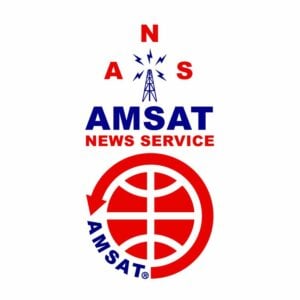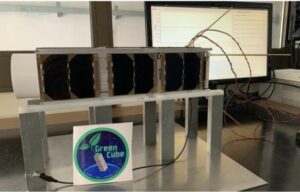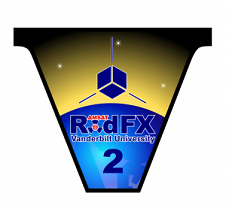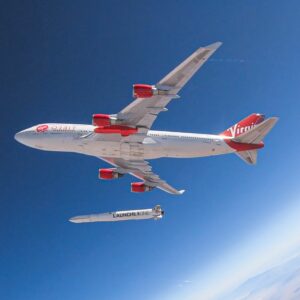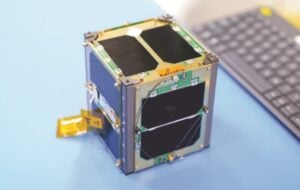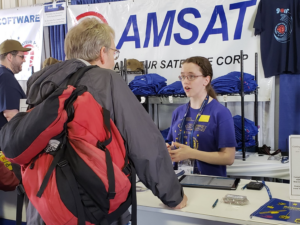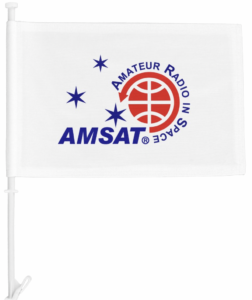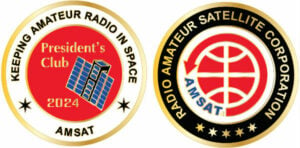In this edition:
* Greencube Terminal Program: Version 1.0.0.90 Enhancements and Updates
* Chang’e-6 Successfully Launches: China’s Historic Lunar Mission Begins
* NASA Reveals SpaceX’s Innovative Plan for Starship Refueling in Orbit
* GridMasterMap Satellite Top 100 Rovers May 2024 Rankings
* Changes to AMSAT-NA TLE Distribution for May 3, 2024
* ARISS News
* Upcoming Satellite Operations
* Hamfests, Conventions, Maker Faires, and Other Events
* Satellite Shorts From All Over
The AMSAT News Service bulletins are a free, weekly news and information service of AMSAT, the Radio Amateur Satellite Corporation. ANS publishes news related to Amateur Radio in Space including reports on the activities of a worldwide group of Amateur Radio operators who share an active interest in designing, building, launching and communicating through analog and digital Amateur Radio satellites.
The news feed on https://www.amsat.org publishes news of Amateur Radio in Space as soon as our volunteers can post it.
Please send any amateur satellite news or reports to: ans-editor [at] amsat.org
You can sign up for free e-mail delivery of the AMSAT News Service Bulletins via the ANS List; to join this list see: https://mailman.amsat.org/postorius/lists/ans.amsat.org/
ANS-126 AMSAT News Service Weekly Bulletins
To: All RADIO AMATEURS
From: Radio Amateur Satellite Corporation
712 H Street NE, Suite 1653
Washington, DC 20002
DATE 2024 May 05
Greencube Terminal Program: Version 1.0.0.90 Enhancements and Updates
The Greencube Terminal Program, developed by Carsten Groen, OZ9AAR, has taken another leap forward in its evolution with the launch of Version 1.0.0.90. This latest update brings a number of enhancements and fixes geared towards bolstering operational efficiency and enriching the user experience, particularly for IO-117 satellite enthusiasts.
One of the standout features of this update is the integration of UHM 2.1 (yoU Heard Me), supplanting the older UHM 2.0. It’s imperative for users to make the switch before May 14th, as UHM 2.0 will quit working thereafter. In the Live World View (LWV), users now have the flexibility to customize the positioning of the “radar view” of the current pass on the screen, allowing for more tailored satellite tracking experiences. Moreover, a bug that caused the frequency/band to default to 435.310 MHz regardless of the satellite selected when logging stations has been rectified.
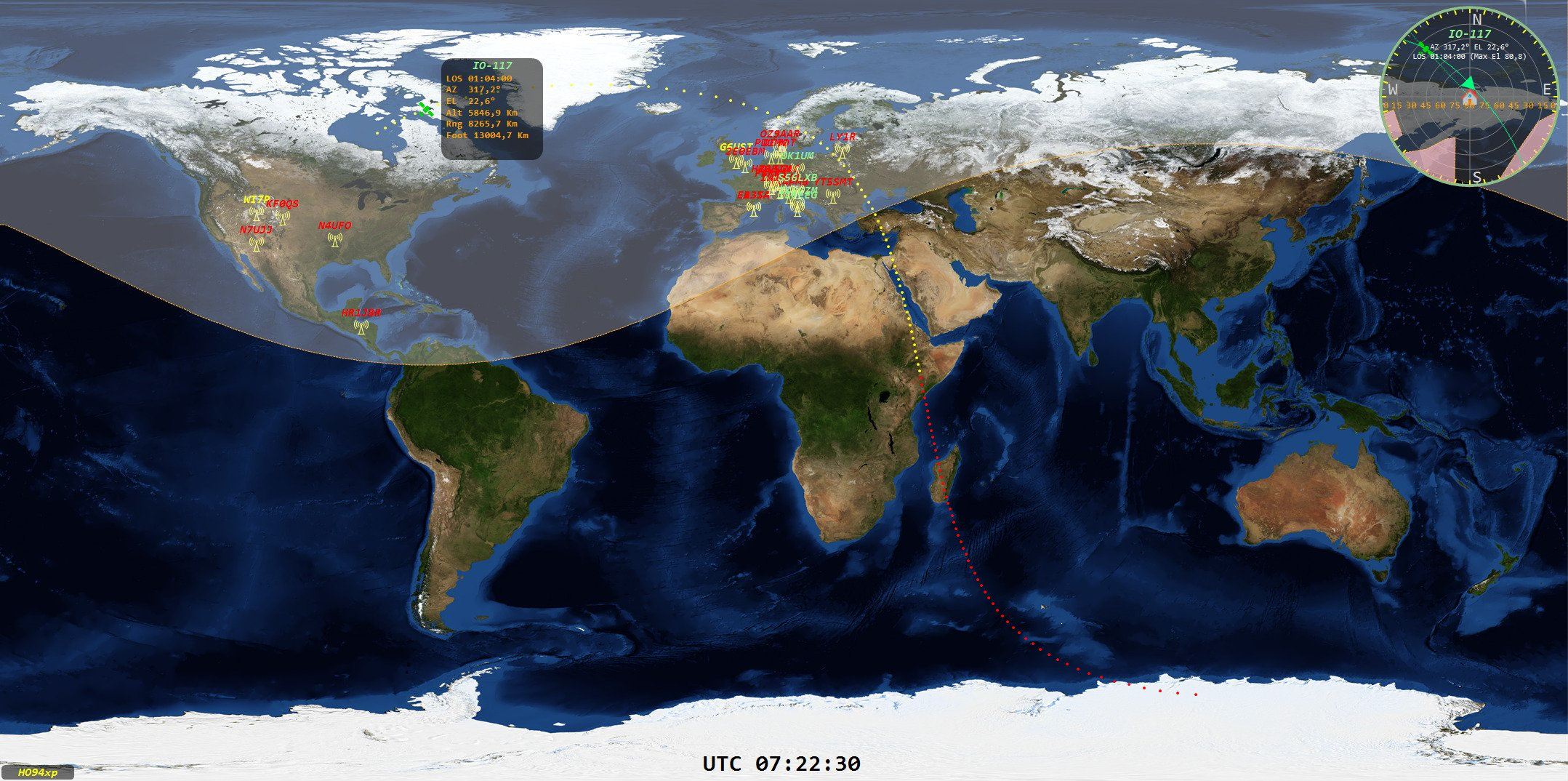
Noteworthy improvements have also been made to message handling within the Terminal program. These include fixes to parsing issues with local TLE data caused by duplicate NORAD numbers and adjustments to the way UHM paints lines in the Traffic view to address reported errors. Furthermore, enhancements to LoTW status checks now ensure that updates occur automatically every 12 hours based on user-configured preferences, streamlining the process and ensuring accuracy.
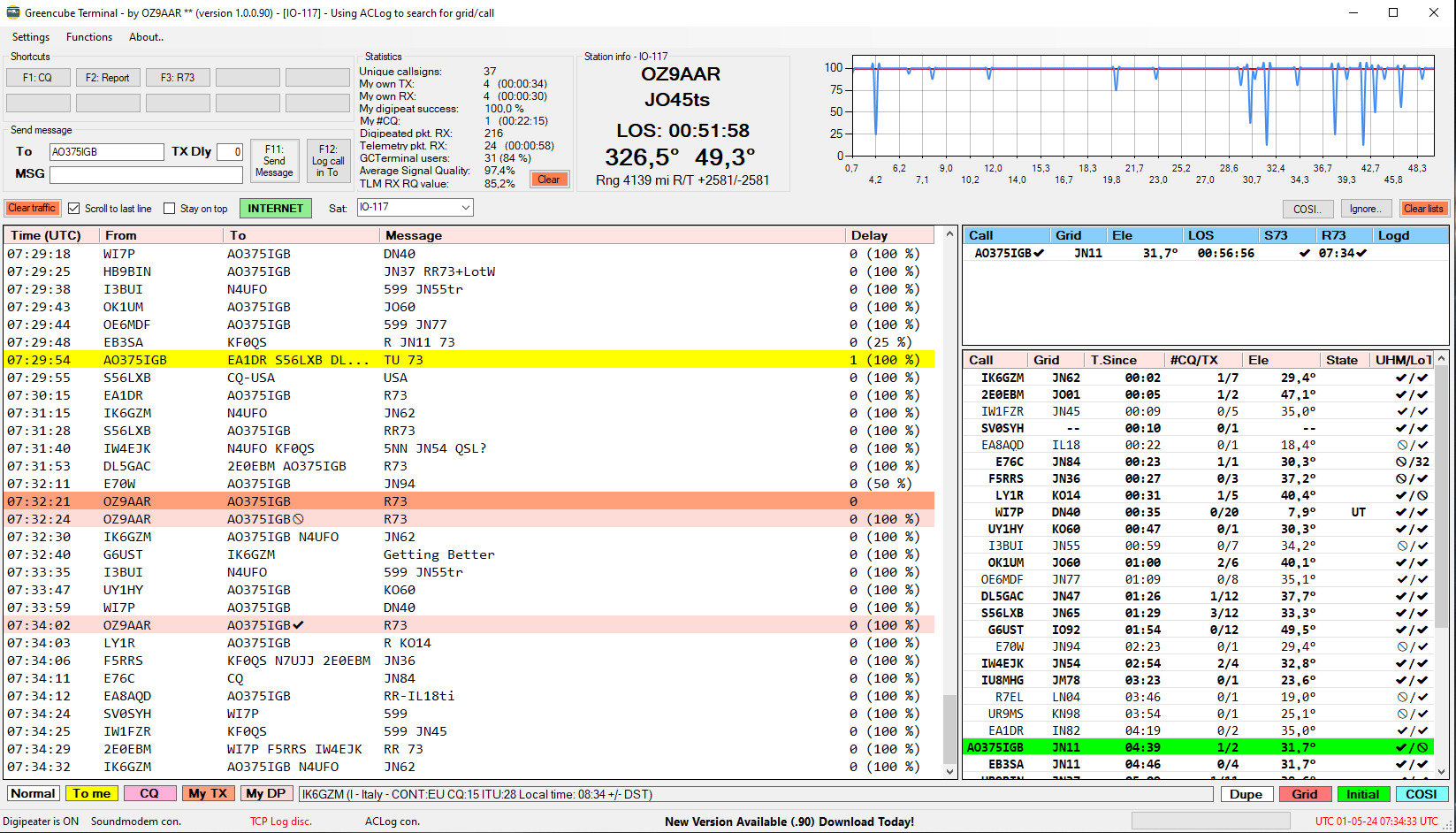
With the addition of features such as UHM integration, expanded satellite selection, and improved message handling, users can anticipate a more robust and user-friendly experience with the Greencube Terminal Program v1.0.0.90. These updates underscore a commitment to continuous improvement and innovation, ensuring Greencube Terminal Program remains the most popular application for GreenCube satellite communications. More information about installation, features, and updates can be found on Carsten’s website: https://www.moonbounce.dk/hamradio/greencube-terminal-program.html.
[ANS thanks Carsten Groen, OZ9AAR, for the above information]
Chang’e-6 Successfully Launches: China’s Historic Lunar Mission Begins
China’s Chang’e-6 mission embarked on its historic journey on May 3rd, launching aboard a Long March 5 rocket from the Wenchang Satellite Launch Center on Hainan Island, China. This mission aims to retrieve samples from the far side of the Moon, a feat never before achieved. The spacecraft is set to undergo a 53-day voyage to the Moon and back, where it will collect lunar soil and rocks, offering invaluable insights into the Moon’s ancient history.
The mission targets the Moon’s South Pole-Aitken (SPA) basin, a region of particular interest due to its potential to unveil crucial information about the Moon’s past. This basin, formed by an ancient impact, holds clues about the events that shaped both the Moon and Earth billions of years ago, providing an opportunity to understand the differences between the near and far sides of the Moon.
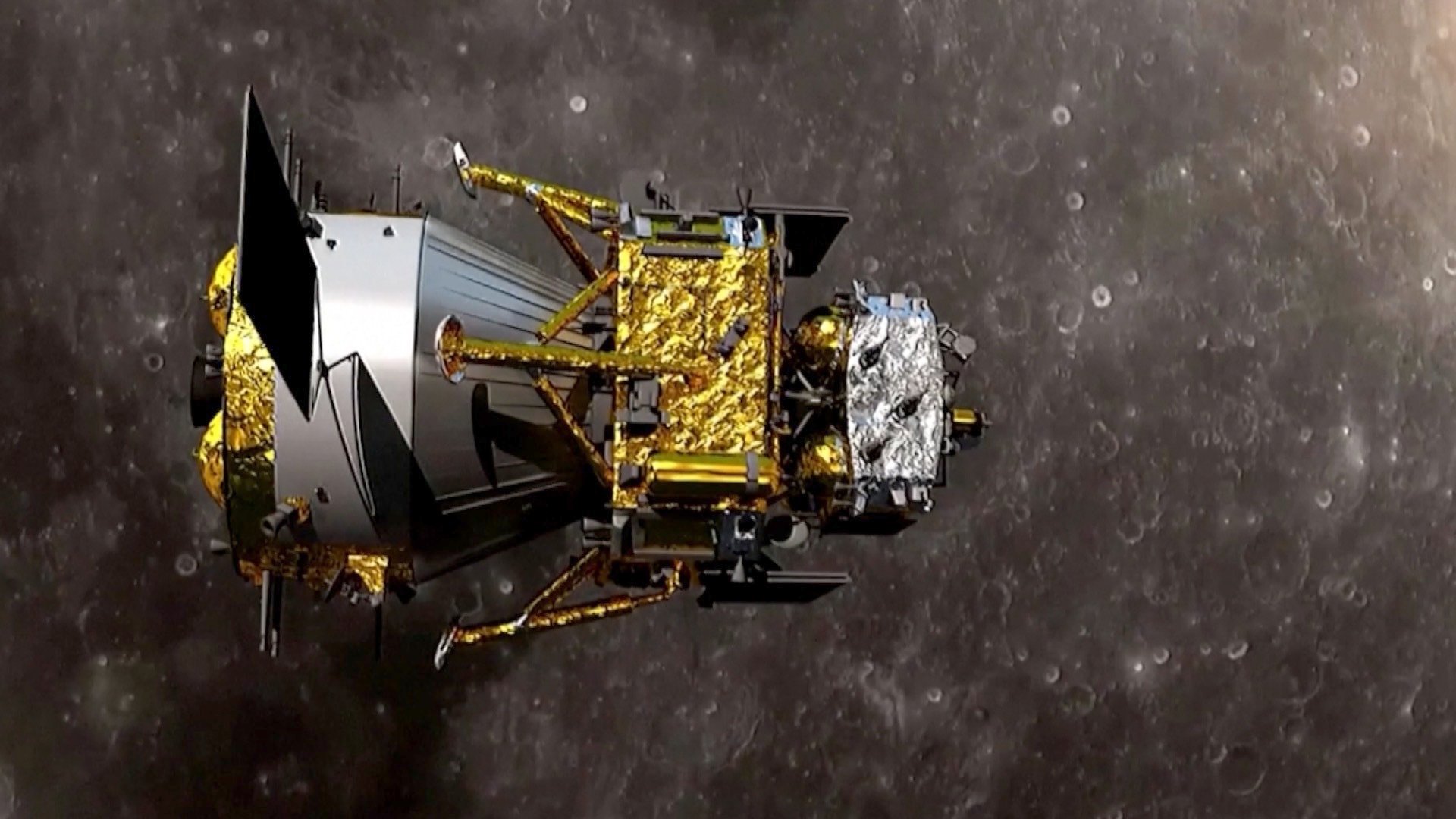
The Chang’e-6 spacecraft is comprised of four components: an orbiter, lander, ascender, and reentry module. Upon reaching lunar orbit, the lander and ascender will descend to the Moon’s surface, collect approximately 2 kilograms (4.4 pounds) of lunar material using specialized tools, and return to lunar orbit. The orbiter will then carry the samples back to Earth, releasing the reentry module into the atmosphere for a soft landing.
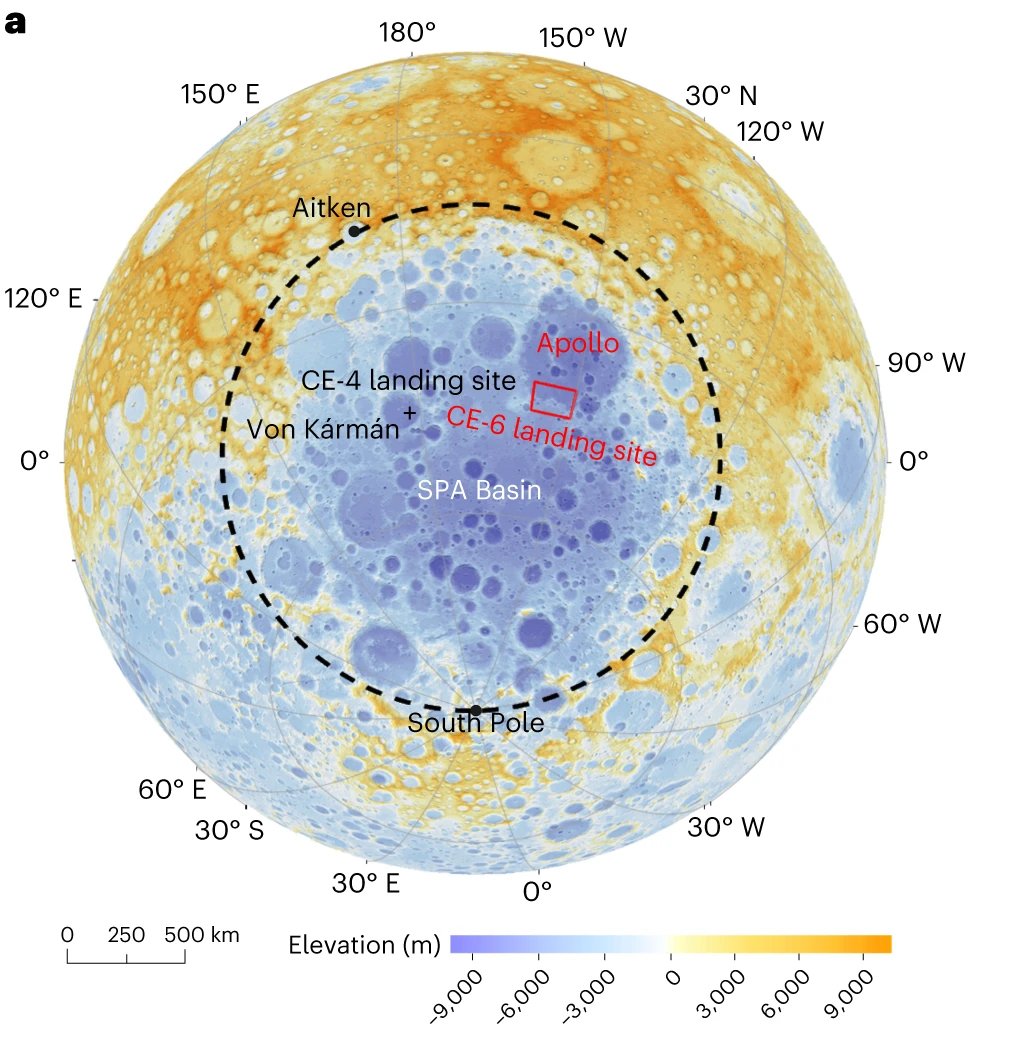
The scientific significance of Chang’e-6 extends beyond lunar exploration. The samples it retrieves will shed light on the Solar System’s tumultuous past, particularly the Late Heavy Bombardment period around 3.9 billion years ago. By studying the SPA basin’s age and composition, scientists hope to discern the origins of this event and its implications for Earth’s history and the potential for life elsewhere in the universe.
[ANS thanks Jason Davis, The Planetary Society, for the above information]
The 2024 AMSAT President’s Club coins are here now!
Help Support GOLF and Fox Plus
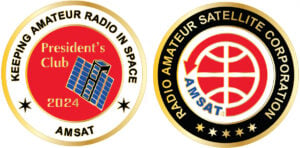 Join the AMSAT President’s Club today and help
Join the AMSAT President’s Club today and help
Keep Amateur Radio in Space!
https://www.amsat.org/join-the-amsat-presidents-club/
NASA Reveals SpaceX’s Innovative Plan for Starship Refueling in Orbit
NASA recently outlined SpaceX’s plans for refueling Starships in low-Earth orbit, a critical step toward enabling ambitious lunar missions. Scheduled for next year, this demonstration involves linking two Starships in orbit. Under contract with NASA’s Artemis program, SpaceX aims to supply human-rated Starships for lunar landings, although the targeted 2026 launch for Artemis III highlights the project’s ambitious nature. Last year, NASA awarded a contract to Blue Origin, providing alternative options for lunar missions. Both companies designed their landers with future refueling capabilities, allowing for multiple missions and potential resource utilization on the Moon or Mars.
Amit Kshatriya, leading NASA’s “Moon to Mars” program, outlined SpaceX’s strategy for in-space refueling during a recent meeting. Despite challenges, progress is evident as SpaceX prepares for upcoming Starship test flights, aiming to tackle crucial technical hurdles. Before lunar missions become a reality, mastering in-space refueling is essential. SpaceX plans to demonstrate large-scale propellant transfer between two Starships in orbit next year. This milestone follows a successful cryogenic propellant transfer test during a previous Starship flight, funded by NASA.
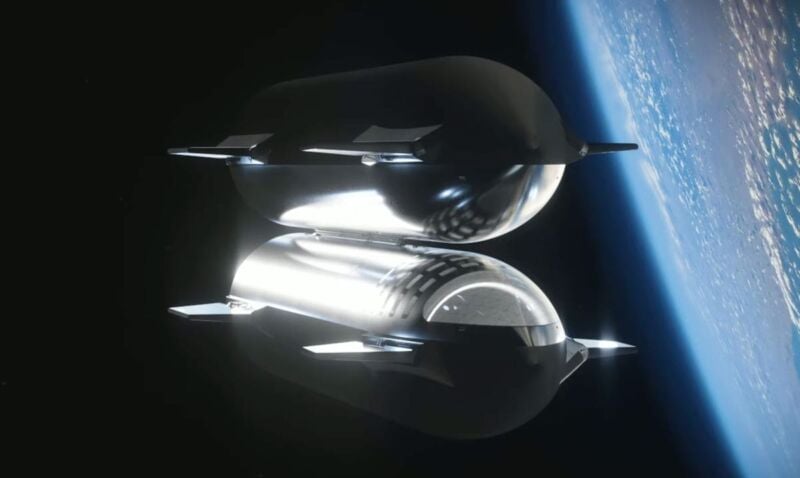
The upcoming refueling demonstration involves autonomously linking two Starships in orbit, a task not without complexities. Yet, leveraging experience from Dragon capsule missions, SpaceX aims to navigate these challenges. The propellant transfer process relies on a pressure differential mechanism, simplifying the flow between donor and recipient tanks. Fine-tuning this procedure is crucial to avoid propellant loss during transfers.
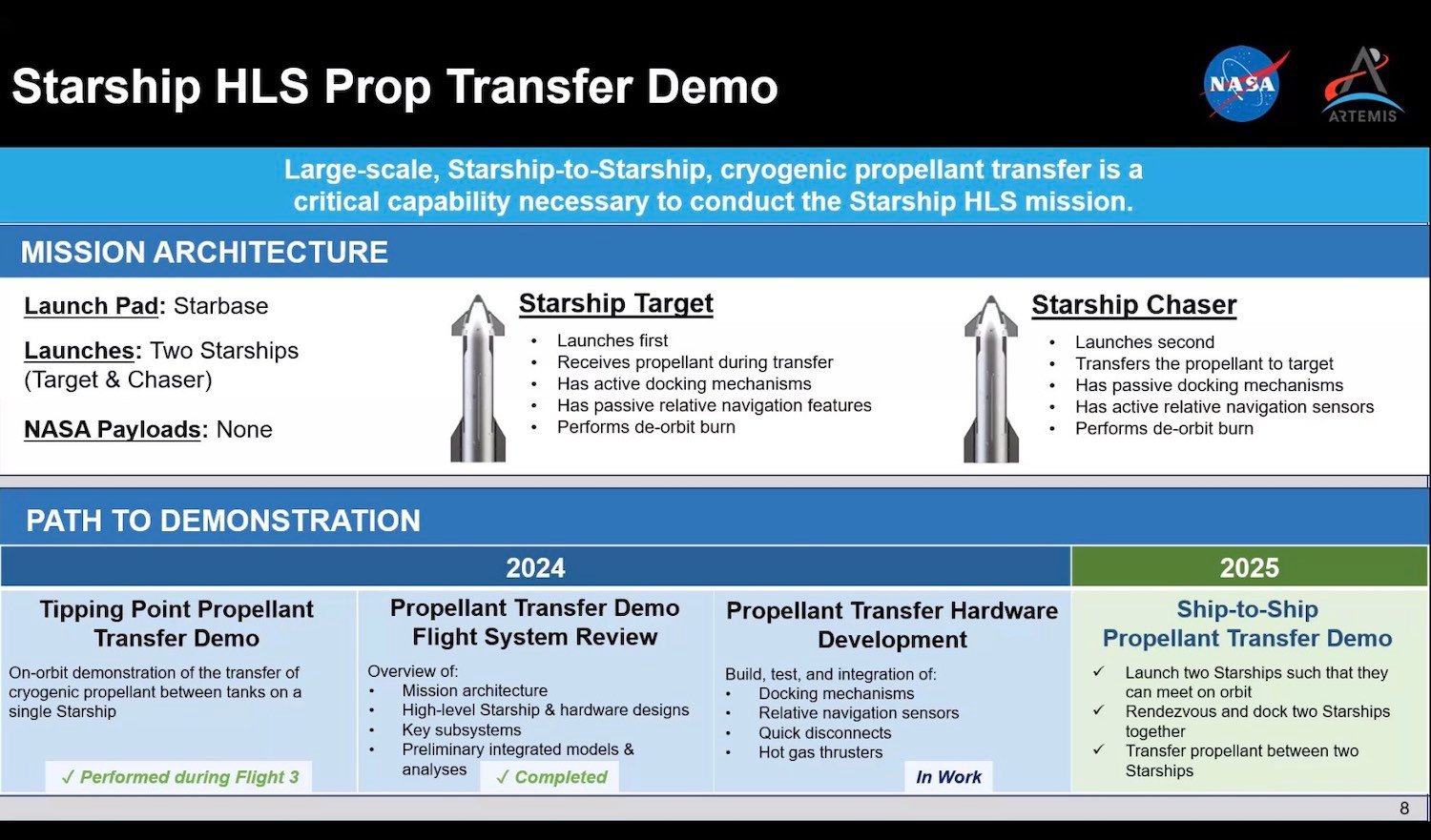
[ANS thanks Stephen Clark, Ars Technica, for the above information]
GridMasterMap Satellite Top 100 Rovers May 2024 Rankings
The May 2024 rankings for the Top 100 Rovers (Mixed LEO/MEO/GEO) in satellite operations, as determined by @GridMasterMap on Twitter, has been released. The ranking is determined by the number of grids and DXCC entities activated, taking into account only those grids where a minimum number of QSOs logged on the gridmaster.fr website have been validated by a third party. Grid numbers do not directly reflect the exact number of activations. Satellite operators are encouraged to upload their LoTW satellite contacts to https://gridmaster.fr in order to provide more accurate data.
Updated: 2024-05-01
| 1 | ND9M | 26 | N5BO | 51 | SP5XSD | 76 | FG8OJ |
| 2 | NJ7H | 27 | K8BL | 52 | AD7DB | 77 | PT9BM |
| 3 | JA9KRO | 28 | LU5ILA | 53 | JL3RNZ | 78 | KJ7NDY |
| 4 | N5UC | 29 | KE4AL | 54 | F4DXV | 79 | KI7UXT |
| 5 | UT1FG | 30 | DL2GRC | 55 | KE9AJ | 80 | YU0W |
| 6 | OE3SEU | 31 | VE3HLS | 56 | KI7QEK | 81 | WA9JBQ |
| 7 | DL6AP | 32 | KB5FHK | 57 | PA3GAN | 82 | N4DCW |
| 8 | WI7P | 33 | KI7UNJ | 58 | N8RO | 83 | HB9GWJ |
| 9 | HA3FOK | 34 | LA9XGA | 59 | XE1ET | 84 | KB2YSI |
| 10 | K5ZM | 35 | F4BKV | 60 | KM4LAO | 85 | N0TEL |
| 11 | N6UA | 36 | N7AGF | 61 | VE1CWJ | 86 | VE3GOP |
| 12 | N9IP | 37 | JO2ASQ | 62 | SM3NRY | 87 | KI0KB |
| 13 | WY7AA | 38 | XE3DX | 63 | N4UFO | 88 | JM1CAX |
| 14 | W5PFG | 39 | K7TAB | 64 | VA3VGR | 89 | CU2ZG |
| 15 | AK8CW | 40 | KE0PBR | 65 | W1AW | 90 | K0FFY |
| 16 | AD0DX | 41 | KE0WPA | 66 | VA7LM | 91 | KG4AKV |
| 17 | DP0POL | 42 | N6DNM | 67 | PT2AP | 92 | AF5CC |
| 18 | WD9EWK | 43 | PR8KW | 68 | M1DDD | 93 | VE6WK |
| 19 | AD0HJ | 44 | AC0RA | 69 | DL4EA | 94 | W8MTB |
| 20 | ON4AUC | 45 | EB1AO | 70 | AA8CH | 95 | VE7PTN |
| 21 | KX9X | 46 | JK2XXK | 71 | N4AKV | 96 | DK9JC |
| 22 | KG5CCI | 47 | W7WGC | 72 | LU4JVE | 97 | K6VHF |
| 23 | ND0C | 48 | EA4NF | 73 | VE1VOX | 98 | N6UTC |
| 24 | DJ8MS | 49 | VK5DG | 74 | W8LR | 99 | PT9ST |
| 25 | F5VMJ | 50 | AA5PK | 75 | DF2ET | 100 | VO2AC |
[ANS thanks @GridMasterMap for the above information]
Need new satellite antennas?
Purchase an M2 LEO-Pack from the AMSAT Store!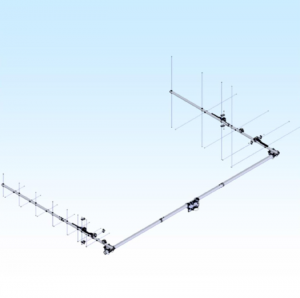 When you purchase through AMSAT, a portion of the proceeds goes towards
When you purchase through AMSAT, a portion of the proceeds goes towards
Keeping Amateur Radio in Space.
https://amsat.org/product-category/hardware/
Changes to AMSAT-NA TLE Distribution for May 3, 2024
Two Line Elements or TLEs, often referred to as Keplerian elements or keps in the amateur community, are the inputs to the SGP4 standard mathematical model of spacecraft orbits used by most amateur tracking programs. Weekly updates are completely adequate for most amateur satellites. TLE bulletin files are updated daily in the first hour of the UTC day. New bulletin files will be posted immediately after reliable elements become available for new amateur satellites. More information may be found at https://www.amsat.org/keplerian-elements-resources/.
Correction to last week’s addition:
KASHIWA NORAD Cat ID 59508 Correct downlink 437.3753 MHz (Thanks Nico PA0DLO)
The following satellites have been removed from this week’s AMSAT-NA TLE distribution:
NIUSAT NORAD Cat ID 42766 Decayed from orbit on or about 27 April 2024
ExoCube 2 NORAD Cat ID 47319 Decayed from orbit on or about 30 April 2024
[ANS thanks AMSAT Orbital Elements page for the above information]
ARISS NEWS
Amateurs and others around the world may listen in on contacts between amateurs operating in schools and allowing students to interact with astronauts and cosmonauts aboard the International Space Station. The downlink frequency on which to listen is 145.800 MHz worldwide.
+ Recently Completed Contacts
Centennial Campus Magnet Middle School Center for Innovation, Raleigh, NC, telebridge via K6DUE
The ISS callsign was NA1SS
The scheduled crewmember was Matthew Dominick KCØTOR
The ARISS mentor was AA6TB
Contact was successful: Wed 2024-05-01 12:03:49 UTC
Watch for Livestream at: https://www.youtube.com/watch?v=lnAZJknxsgw
Wireless Institute of Australia / Bundaberg High School Amateur Radio Club, Bundaberg, Queensland, Australia, telebridge via VK6MJ
The ISS callsign was NA1SS
The scheduled crewmember was Mike Barratt KD5MIJ
The ARISS mentor was VK4KHZ
Contact was successful: Sat 2024-05-04 10:28:24 UTC
+ Upcoming Contacts
Eric Knows CIC, Newcastle upon Tyne, United Kingdom, telebridge via K6DUE
The ISS callsign is presently scheduled to be NA1SS
The scheduled crewmember is Matthew Dominick KCØTOR
The ARISS mentor is MØXTD
Contact is go for: Sat 2024-05-11 08:42:32 UTC
The crossband repeater continues to be active (145.990 MHz up {PL 67} & 437.800 MHz down). If any crewmember is so inclined, all they have to do is pick up the microphone, raise the volume up, and talk on the crossband repeater. So give a listen, you just never know.
The packet system is also active (145.825 MHz up & down).
As always, if there is an EVA, a docking, or an undocking; the ARISS radios are turned off as part of the safety protocol.
Note, all times are approximate. It is recommended that you do your own orbital prediction or start listening about 10 minutes before the listed time.
The latest information on the operation mode can be found at https://www.ariss.org/current-status-of-iss-stations.html
The latest list of frequencies in use can be found at https://www.ariss.org/contact-the-iss.html
[ANS thanks Charlie Sufana, AJ9N, one of the ARISS operation team mentors for the above information]
Upcoming Satellite Operations
A growing number of satellite rovers are currently engaged in sharing their grid square activations on https://hams.at. By visiting the website, you gain easy access to comprehensive information about the operators responsible for activating specific grid squares. Additionally, you have the ability to assess the match score between yourself and a particular rover for a given pass, while also being able to identify the upcoming satellite passes that are accessible from your location.
[ANS thanks Ian Parsons, K5ZM, AMSAT rover page manager, for the above information]
Hamfests, Conventions, Maker Faires, and Other Events
AMSAT Ambassadors provide presentations, demonstrate communicating through amateur satellites, and host information tables at club meetings, hamfests, conventions, maker faires, and other events.
Dayton Hamvention 2024
Friday May 17th – Sunday May 19th
Greene County Fairgrounds and Expo Center
120 Fairground Road
Xenia, OH 45385
https://hamvention.org
38th Annual Small Satellite Conference
August 3-8, 2024
Logan, UT, USA
https://smallsat.org
[ANS thanks the AMSAT Events page for the above information]
Want to fly the colors on your own grid expedition?
Get an AMSAT car flag and other neat stuff from our Zazzle store!
25% of the purchase price of each product goes towards Keeping Amateur Radio in Space
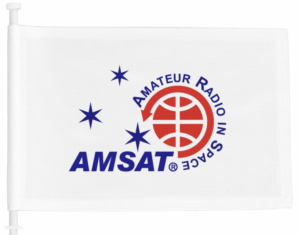 Keeping Amateur Radio in Space
Keeping Amateur Radio in Space
https://www.zazzle.com/amsat_gear
Satellite Shorts From All Over
+ Congratulations are in order for RJ Bragg, WY7AA, and Andrew Northam, KE8FZT, for their impressive accomplishments in earning GridMaster Awards #64 and #65, respectively! This esteemed recognition, initiated by Star Comm Group in 2014 and backed by Damon Runion, WA4HFN, and Rick Tillman, WA4NVM, has now been entrusted to AMSAT for the benefit of the entire amateur satellite community. The GridMaster Award celebrates radio amateurs worldwide who achieve two-way communication via amateur satellite with operators in all 488 Maidenhead grids across the contiguous United States of America. For more details on this distinguished award, visit the AMSAT website at https://www.amsat.org/gridmaster/. Andrew and RJ, your achievement is truly commendable—well done! (ANS thanks Bruce Paige, KK5DO, AMSAT Director of Contests and Awards for the above information)
+ AMSAT Italia proudly announces the acquisition of ownership of the IO-117 “GreenCube” satellite, with Sapienza University retaining partial ownership. Through collaboration, the satellite will continue amateur radio operations post-primary scientific mission completion, preventing its decommissioning. This transfer of legal responsibility from the Italian Space Agency to AMSAT Italia solidifies the satellite’s exclusive amateur radio use. Originally named GreenCube, it was developed by Sapienza University, ENEA, and University of Naples Federico II, with AMSAT Italia contributing to its design. On October 29, 2022, GreenCube became the first ham radio satellite to operate in a MEO orbit, designated as Italy-OSCAR 117 (IO-117) by AMSAT. AMSAT Italia, Sapienza Space Systems, and Space Surveillance Laboratory commit to operating the satellite for continued service to the amateur radio community. (ANS thanks AMSAT Italia for the above information)
+ Boeing’s Crew Flight Test (CFT) of the CST-100 Starliner spacecraft is scheduled for Monday, May 6, with a targeted launch time of 10:34 p.m. EDT. Led by Commander Barry “Butch” Wilmore and Pilot Suni Williams, both experienced NASA astronauts, this mission comes after over a decade in development. The duo will spend at least eight days aboard the International Space Station (ISS) conducting various flight test objectives before returning for a solid-ground landing. Wilmore and Williams will be the first humans to fly atop the United Launch Alliance (ULA) Atlas V rocket since 1963 and execute the first “land” landing of a crew-carrying U.S. spacecraft since 2011. Originally not slated for this mission, Wilmore and Williams stepped in after several crew changes, with Williams set to become the first woman to fly the maiden voyage of a new orbital-class vehicle. Deep into pre-flight quarantine, the astronauts express their readiness, acknowledging the challenges and the learning opportunities that lie ahead in this ambitious test flight. (ANS thanks Ben Evans, AmericaSpace, for the above information)
+ On April 25, 2024, Roscosmos cosmonauts Oleg Kononenko and Nikolai Chub conducted a successful spacewalk, lasting four hours and 36 minutes, to install communication and corrosion analysis equipment on the International Space Station (ISS). The spacewalk aimed to deploy a communications system and install equipment to analyze corrosion levels on station surfaces. Kononenko, with seven spacewalks under his belt, and Chub, on his second, completed their tasks, including deploying a panel for a synthetic radar communications system on the Russian segment of the ISS. This mission marked the 270th spacewalk for assembly, maintenance, and upgrades of the space station, with Kononenko and Chub having arrived at the station on September 15, 2023, aboard the Soyuz MS-24 spacecraft. (ANS thanks SciTechDaily.com, for the above information)
+ Two new Galileo navigation satellites were launched from Kennedy Space Center on Saturday, April 27th, at 8:34 p.m. EDT, bolstering the system’s constellation to 30 satellites and amplifying reliability and precision for billions of users globally. Since its inception in 2016, Galileo has been pivotal across various sectors such as rail, maritime, agriculture, and rescue operations, contributing significantly to the EU’s GDP, with 10% reliant on satellite navigation. This launch follows the recent introduction of the new Public Regulated Service signals, further solidifying Europe’s independence in satellite navigation. Notably, this marks the first time Galileo satellites have been launched aboard an American-made rocket, a significant development amid Europe’s diminishing space collaboration with Russia. (ANS thanks the European Space Agency, for the above information)
+ SpaceX’s 30th Dragon cargo mission successfully returned to Earth, splashing down off the coast of Florida in the early hours of April 30th. Departing from the International Space Station on April 28th, the capsule completed its mission under the CRS-30 contract with NASA. Loaded with over 4,100 pounds of supplies and scientific experiments, Dragon is unique in its capability to safely bring gear back from the ISS, unlike other operational spacecraft that burn up upon reentry. This return enables quick transportation of experiments to NASA’s facilities for data collection. Meanwhile, another SpaceX vehicle remains docked at the ISS, supporting the Crew-8 astronaut mission for NASA, launched in early March. (ANS thanks Mike Wall, Space.com, for the above information)
Join AMSAT today at https://launch.amsat.org/
In addition to regular membership, AMSAT offers membership to:
* Societies (a recognized group, clubs or organization).
* Primary and secondary school students are eligible for membership at one-half the standard yearly rate.
* Post-secondary school students enrolled in at least half-time status shall be eligible for the student rate for a maximum of 6 post-secondary years in this status.
* Memberships are available for annual and lifetime terms.
Contact info [at] amsat.org for additional membership information.
73 and remember to help Keep Amateur Radio in Space!
This week’s ANS Editor, Mitch Ahrenstorff, ADØHJ
ad0hj [at] amsat.org

